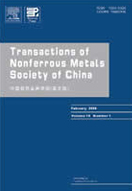Superelastic damping of TiNi alloy wire under heavy
mechanical shock in structural engineering①
mechanical shock in structural engineering①
(1. School of Materials and Chemical Engineering, Liaoning Institute of Technology,
Jinzhou 121001, China;
2. School of Civil Structural Engineering, Southeast University, Nangjing 210096, China)
Jinzhou 121001, China;
2. School of Civil Structural Engineering, Southeast University, Nangjing 210096, China)
Abstract: Based on superelastic damping application in structural engineering, the damping characteristics of commercial Ti-50.8Ni(mole fraction, %) alloy have been systematically studied by adjusting frequency of mechanical shock, temperature, stress, strain and number of cycling. The results show that at extremely low frequency mechanical shock at room temperature, the superelastic damping capacity increases with controlled strain, and such capacity of each cycle is greater than 50%. When the frequency of mechanical shock is 0.1 0.3 Hz, the superelastic damping capacity above room temperature is relatively large at high strain; when the temperature approaches toMd, the damping begins at low stress. For specimen cycled under 0.5 Hz, above 6% strain mechanical shock at relatively high temperature, further large-strain cycling exhibits more than 35% damping capacity. The superelastic damping of trained specimen is relatively stable at 20 -50℃and 0.1 0.5 Hz frequency mechanical shock.
Key words: NiTi alloy; superelastic damping; low frequency mechanical shock; structural engineering

